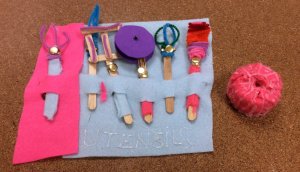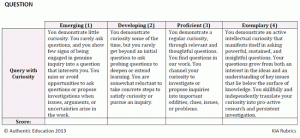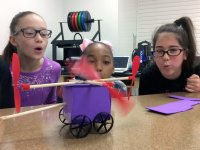Middle School Maker Journey: Assessment in an Ungraded Classroom
In part seven of his year-long series, Kevin Jarrett examines the role of student reflection and the challenges of assessment in his (ungraded) middle school makerspace.
Your content has been saved!
Go to My Saved Content."I'm done!"
Those two words have extra special meaning in my program because, generally speaking, student design work is never really finished -- it's just ready for another iteration. What, then, is the role of assessment, especially in an ungraded program such as mine? Who should do the assessing? Me, as lead learner? The student? Others? All of the above? In this month's post, I'm sharing our experience with assessment thus far in Digital Shop, plus assessments of our planned capstone projects.
Starr Sackstein, MJE, NBCT, says, "We need to make sure that we are offering students awesome learning experiences that are well thought out and fun. They will be undoubtedly put in the work if they are engaged in what is happening." We've certainly found this to be true in Digital Shop. Despite having no experience whatsoever with design thinking, students have risen to the design challenges they've encountered, often with spectacular results. Engagement has been off the charts. Classroom discipline issues have been virtually non-existent. While this isn't assessment per se, it remains an important indicator of our program's success.

Mirror, Mirror, on the Wall. . .
Reflections, so far, have been our most effective method of assessing performance (and a feedback loop for me as lead experience designer). Although students routinely work on group projects elsewhere in school, and are often asked to evaluate themselves and others, the nature and approach of our work in Digital Shop (and the absence of a formal class grade) makes the reflection process a different experience, in which students express themselves more freely, clearly, and critically.
Consider these submitted responses:
These responses have enabled me to better coach students on skills that they need to develop, and to compliment them on strengths that they already exhibit. For example, when peers describe a student as struggling creatively, I can ask questions that help the student begin to see his or her creative talents from another perspective. When a student is described as being too task oriented or authoritarian (an observation that I confirm personally), I start a conversation about group dynamics and leadership styles. When a student is praised for technological competence, I let him or her know how that ability helped the team's performance overall. This has proven very effective for me as the lead learner, and based on the feedback that I've gotten, very effective for students as well.
Finally: Our Capstones
Each of our grade levels will have a different capstone project this year. (Three have been determined, and the fourth is still under development.) As we progress toward these design challenges, assessment looms larger in my mind, primarily because I want the students' experiences to be as powerful as possible. Remember, there are no formal grades in my class.
Tony Wagner's Seven Survival Skills also loom large as I ponder the assessments that will conclude the school year for these kids. The skills are:
- Critical thinking and problem solving
- Collaboration across networks and leading by influence
- Agility and adaptability
- Initiative and entrepreneurship
- Effective oral and written communication
- Accessing and analyzing information
- Curiosity and imagination
These are good reasons for having makerspaces in schools, and why I believe the maker movement is so powerful. I can't imagine better lenses through which to assess my students' skills and abilities as demonstrated in their upcoming capstones. Fortunately, I've found some tools to help me do just that.
Some time ago, my colleague Mike Ritzius referred me to a fantastic set rubrics, the work of the late Grant Wiggins and Denise Wilbur at Authentic Education. Known as KIA (Key Indicator of Ability) rubrics, they focus on six distinct competency areas:
- Question
- Infer
- Create
- Communicate
- Evaluate
- Argue
Rather than being hierarchical, they are "meant to spiral in complexity and span across contexts, so a well thought out curriculum for a grade level will have students engaging in all of them in different subjects at different times." Take a look at the first page of the Question rubric:

As of this moment, I plan to use the Question, Create, and Communicate rubrics in two ways. First, I will use them myself to assess the student teams individually and their final projects overall. Second, I will give students a version of the rubric, translated to an appropriate reading level, to evaluate their own performance and their team's as well. I'll use a Google Form to ease data gathering and analysis through a series of quantitative and qualitative questions developed from those three KIA rubrics. My goal is turning the last day of the final Design Experience into part gallery walk, part celebration, and part reflection exercise. Since I have the students in six-week cohorts, I should be able to assess roughly 20 projects representing about 70 students in grades 5-8 each time. (That's the plan, anyway!)
I’ve worked hard to craft each Design Experience so that students are building creative confidence, teamwork ability, and tool fluency. I want them to trust their instincts and kid-level perspective on the world. I want them to work effectively with others and know how to communicate powerfully. I want them to feel confident working with their hands to create physical representations of their ideas using everything from a hot glue gun to a 3D design environment (like Autodesk's free and fantastic Tinkercad). And I want them to easily use state-of-the-art groupware like Google Apps for Education to tie it all together.
If all goes as planned, not only will my students have the tools for tackling their design challenges, working together effectively, and reasoning and questioning tenaciously, they'll also be well equipped to ultimately come up with an effective design that elegantly, powerfully meets a real person's need. I'm convinced that these assessments will help.
What assessments are you using in your makerspace or maker-inspired studio? Tell us in the comments! As always, thanks for reading and sharing. Next month, I'll revisit the start of our program and our Manifesto, talking about how it came to be, how it informs the work we do, and how it impacts student learning.
